Text
Assessment 3 - Critical overview
Vernon Ah Kee’s works in the Unlimited series (2011), and the fantasies of the good series (2004), pose contrasting images of First Nations identity in the colony.
Foremost, the Unwritten series presents First Nations identity, as envisioned by white Australia; voiceless, alien-like, unsettling. The figures appear to have human-like characteristics of a person’s ambiguous silhouette, and holes for eyes. However, they are stripped of any distinct traits that would mark them as definitively humane and unique individuals. Just like Blackfellas in the colony, these ‘non-people’, are robbed of their ability to have agency over their identity. Instead, so called ‘Australia’ sees us as an anomaly; something too black and seemingly inferior, to be classified as human along with the more esteemed species- the white person.
In comparison, the fantasies of the good series present comprehensive family portraits, that are raw and undeniably human. This poses First Nations identity as we know it to be; strong, sovereign, defiant. Despite the colony’s strenuous efforts to extinguish our communities, we are still here, and we demand white Australia to see us.
Ah Kee’s exploration of First Nations identity through his work, exemplifies the importance of Indigenous art in enabling self-determination. White Australia has a rigid construction of what an Indigenous person should be, and how we can create and produce artwork in contemporary society. However, Indigenous artists reclaim identity through their work, showing the more nuanced and three-dimensional reality of what it means to be First Nations.
Furthermore, as discussed by Robert Stuurman (2003), Indigenous peoples are often boxed into a suppressive binary, and not allowed to exist as their true selves in modern society. Where Indigeneity is seen as a weakness, the colony works to dehumanise Blackfellas, to instil in us a sense of shame about who we are as a people. In Stuurman’s opinion, a primary defence against this is having a shared awareness of our true identity and expressing our culture to survive. Pointedly, artistic expression is an effective way to do this.
Additionally, Indigenous artist collectives and collaborative projects have become a powerful tool in aiding this exploration of identity. The Meanjin-based, ProppaNOW collective has become an avenue for Indigenous artists to express themselves, and their culture, outside of the constraints of white Australia. The Jus’ Drawn exhibition in 2011, portrays the contributing artists’ ideas on identity, and where they fit in as Indigenous artists in the colony. At its core, it affords Indigenous peoples agency in cultural and individual expression, enabling us to rewrite the outdated fable told by white Australia.
Overall, Indigenous existence can be complicated in contemporary society, where First Nations identity is dictated by the coloniser. However, through artistic expression, such as the works of Ah Kee, Indigenous peoples are able to reclaim their own identity.
0 notes
Text
0 notes
Text
Aboriginal identity in the colony
Focused Area: Visual Arts
Chosen Artist: Vernon Ah Kee
Theme: Aboriginal identity in contemporary society
White Australia’s fable of homogeneous and animalistic ‘natives’, is based upon the colonial perception that to be non-White, is to be inherently inferior and two-dimensional. However, this is a stark contrast to the true identity of Aboriginal people, as the strength and wisdom of our ancestors courses through our veins. As such, artwork that explores Aboriginal identity within contemporary society is a visual representation of defiance in the face of oppression, sovereignty, and survival. These are the key themes I seek to examine in appreciating the work of Vernon Ah Kee.
Vernon Ah Kee is a Kuku Yalandji, Waanki, Yidinji and Gugu Yimithirr man. His art explores the racism running rampant in colonised Australia, and challenges colonial perceptions of Aboriginal identity. As stated by Ah Kee, “Australia, as a country, as an idea, as an ideal, as a social-political system, thinks of and believes itself, despite its history of racism and exclusion, to be essentially good. I of course disagree. These drawings and what they represent are my evidence” (Ah Kee, 2004).
The Unwritten (2007) series, depicts what Ah Kee calls his ‘non-people.’ These bodies are given strokes of humanness with gaping holes for eyes, the shape of an obtrusive nose, and vague outlines of flesh. They are reminiscent of humans, but their presence is alien-like and empty, without any distinct or recognisable features. This speaks to the experience of being Aboriginal in the colony, where we are ‘othered’ and stripped of agency and voice. In the eyes of colonised Australia, we are ‘less than’, and not quite white enough to inhabit the space of human and be worthy of rights, equality, and dignity.
In contrast, Ah Kee’s detailed portraits of family members in fantasies of the good (2004), poses the opposite image of Aboriginal people as inherently human. Whilst the portrait expressions are seemingly neutral, their defiance and strength are imminent. Notably, the most poignant aspect of the drawings is the portrait’s eyes; gazing into the observer, demanding recognition and daring them to look deeply. As well as this, the portrayal of family lineage, with the genetic resemblance clear between each drawing, represents the continuation of Aboriginal culture and existence, despite the colony’s hateful efforts to ‘breed us out’. We are still here, and we are not going anywhere.
To explore notions of Aboriginal identity and what it means to be Blak in white Australia, my plan is to compare the work by Ah Kee that speaks to the coloniser’s perception of Indigeneity, with his art that demonstrates the real and nuanced identity of being Aboriginal. Whilst it is important to acknowledge that Aboriginal peoples are a diverse and multi-faceted group, we share the common story of surviving in the colony and art can be a powerful reminder of this. I beg the question: What does it mean to be Aboriginal in this colony? And, how is this expressed through art?
0 notes
Text
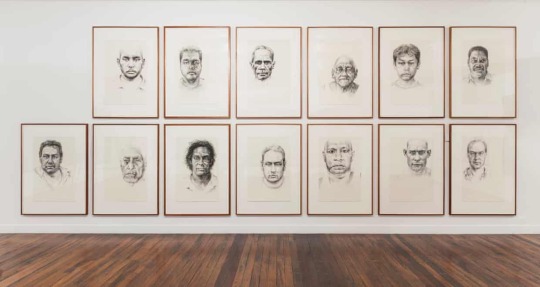
Vernon Ah Kee
fantasies of the good, 2004
Available at: https://art.base.co/product/1755-vernon-ah-kee-fantasies-of-the-good
0 notes
Text
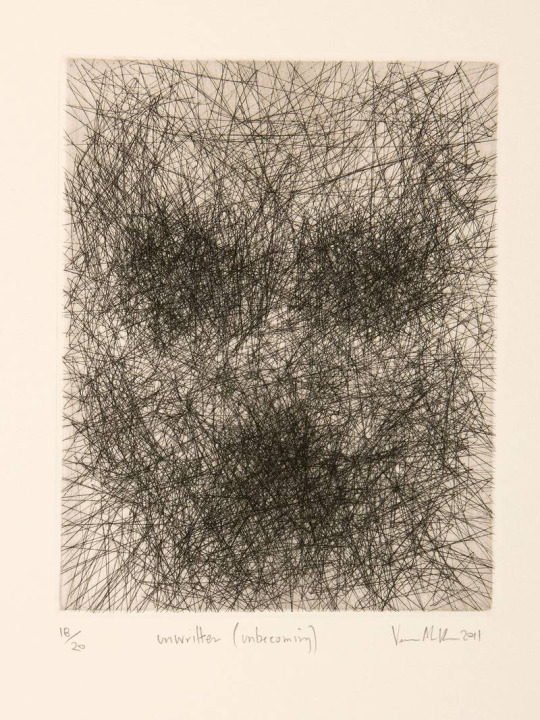
Vernon Ah Kee
unwritten (unbecoming), 2011
Medium: etching on paper
Dimensions: 40x30cm
Available at: https://www.mca.com.au/artists-works/works/2013.29/
0 notes
Text
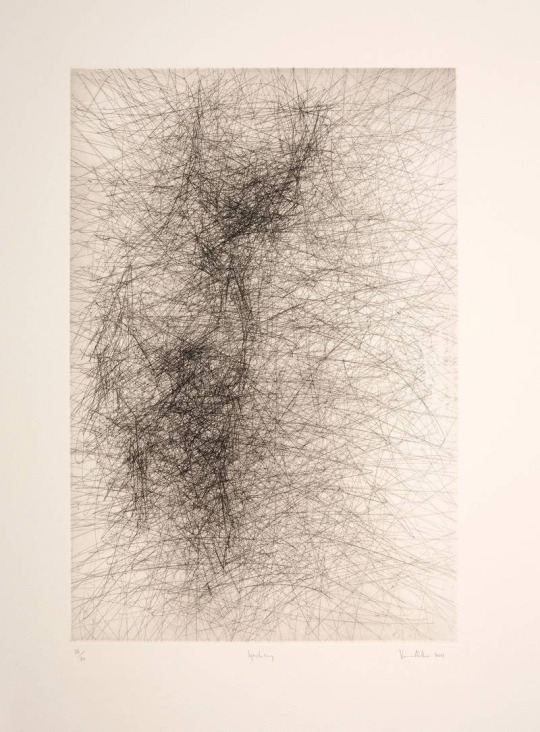
Vernon Ah Kee
lynching, 2011
Medium: etching on paper
Dimensions: 70x50.5cm
Available at: https://www.mca.com.au/artists-works/works/2013.28/
1 note
·
View note
Text
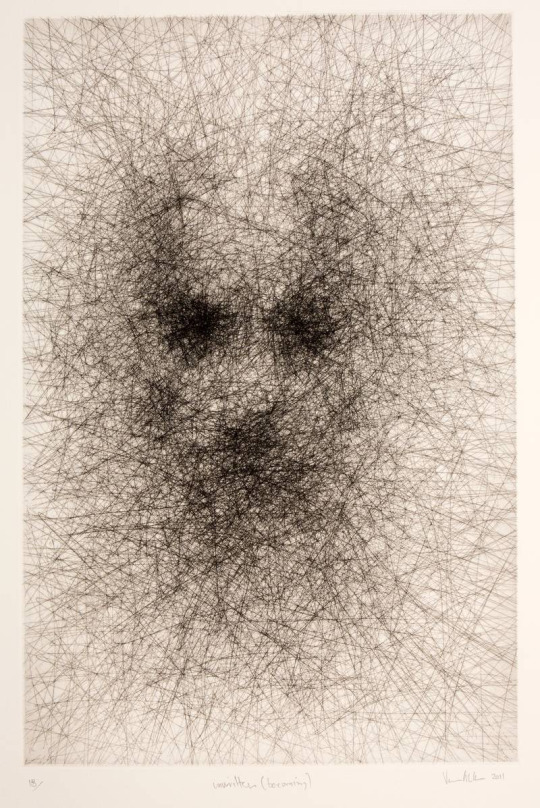
Vernon Ah Kee
unwritten (becoming), 2011
Medium: etching on paper
Dimensions: 70.5x50cm
Available at: https://www.mca.com.au/artists-works/works/2013.27/
0 notes
Text
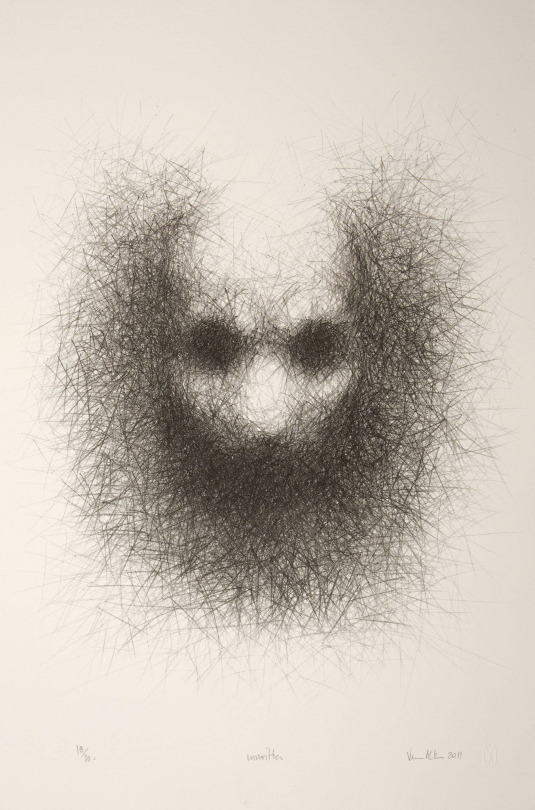
Vernon Ah Kee
unwritten, 2011
Medium: lithograph
Dimensions: 57x38cm
Available at: https://www.mca.com.au/artists-works/works/2013.33/
0 notes
Text
Annotated Bibliography
Huggins, J. (2022). Sister girl: Reflections on tiddaism, identity, and reconciliation. University of Queensland Press.
This source provides a comprehensive reflection on Aboriginal identity and the mechanisms of oppression in Australia, particularly those relating to First Nations women. This is significant to Ah Kee’s work as it provides the background to the important of his art, and the portrayals of conflicting identity. It is written by the esteemed author and advocate, Dr Jackie Huggins, a Bidjara and Birri Gubba Juru woman. Through my citations, I recognise that it is critical to prioritise centring the perspectives of Aboriginal women and gender diverse folk, as their experiences are commonly excluded from main discourse.
Evans, M., & Sinclair, A. (2016). Containing, contesting, creating spaces: leadership and cultural identity work among Australian Indigenous arts leaders. Leadership, 12(3), 270-292. https://doi.org/ 10.1177/1742715015620463
This article examines the broad relationships between art expression, leadership, and Aboriginal identity. It demonstrates how leaders in Indigenous art embody Aboriginality through their art form and contradict stereotypes to find self-determination. This further explores the division between mainstream views of Aboriginality, and demonstrates the leadership and strength in Aboriginal identity.
Heiss, A. (2022). Am I black enough for you?: Ten years on. Random House Australia.
This book, written by acclaimed author and Wiradjuri woman, Dr Anita Heiss, explores ideas of Aboriginal identity in contemporary Australian society. It challenges colonial stereotypes and represents the heterogeneity in Aboriginal peoples. It demonstrates parallels with Ah Kee’s work by opposing the false perceptions of white Australia.
Watego, C. (2021). Another day in the colony. University of Queensland Press.
In this novel, Professor Chelsea Watego, a Munanjahli and South Sea Islander woman, provides an insightful reflection on Aboriginal oppression and stereotyping in the colony. Whilst not explicitly about art forms, it analyses important themes such as sovereignty and activism, relevant to the topic of identity expressed through art. It will be useful in analysing the dynamics of Aboriginal identity, relevant to Ah Kee’s work.
Joss, S. M. (2004). Beyond the Dreamings: Identity and representation in Australian Aboriginal urban art. [Doctoral Dissertation, American University]. ProQuest. https://dra.american.edu/islandora/object/thesesdissertations%3A3101/datastream/PDF/view
This source collates perspectives from various Aboriginal artists, as well as non-Indigenous consumers of art, to digest the link between identity and contemporary Aboriginal art forms. It compares racially motivated depictions of Indigeneity, with the activism and reclamation present in Aboriginal modern art. It is an extensive document, and as such, provides a comprehensive insight into themes topical to Ah Kee’s work, such as finding identity in art, representation, and racism.
Ah Kee, V., & McIntrye, S. (2022). nothing important happened today: An Interview with Vernon Ah Kee. The Journal of the Pacific Arts Association, 22(2), 11-26. https://doi.org/10.5070/PC222259587
Whilst explicitly about Ah Kee’s 2021 exhibition, nothing important happened today, this transcript also enables unique insight into Ah Kee’s intention when creating art. This is particularly important when discussing the role of his art in the political landscape, and relating his work to ideas of sovereignty and identity. It is important to understand the perspective of the artist to discern the messages in their work, especially when the art has a cultural significance.
Museum of Contemporary Art Australia. [MCA Australia]. (2015, Nov 19). Vernon Ah Kee interviewed in 2006 for MCA Artist Voice [Video}. Youtube. https://www.youtube.com/watch?v=UU-YYflHDXo
This specific video is about Ah Kee’s 2006 collection, fantasies of the good. It allows for an in-depth appreciation of Ah Kee’s background and the meaning behind these powerful portraits in relation to Aboriginal identity. As they are portraits of his family and ancestors, it is imperative that Ah Kee’s perspective is appreciated when viewing the artwork.
Moreton-Robinson, A. (Ed). (2004). Whitening race: Essays in social and cultural criticism. Aboriginal Studies Press.
This source provides the necessary background to contextualise Ah Kee’s work through the discussion of Australia’s ongoing racism and dispossession of Aboriginal peoples. It was collated by Goenpul woman, Professor Aileen Moreton-Robinson, who is a credible and discerning scholar. Furthermore, chapters in the book are dedicated to the white perception of Aboriginality, and the racist representations of our peoples that have poisoned mainstream discourse. This is useful for dissecting the dichotomy between colonial perceptions, and reality.
Stuurman, R. (2003, June 19). Aboriginal identity in contemporary society [Paper presentation]. Access to Indigenous Records National Forum.
This is a powerful source that discusses the dynamics of existing as an Aboriginal person in white Australia, and findings ones’ identity. It theorises how identity is defined and constructed in contemporary society, and where Aboriginality fits into this mould. Relevant to Ah Kee’s work, it also recognises ties to art as an expression of identity and opposition to colonial views.
Fredericks, B., & Bradfield, A. (2021). Affirming Aboriginal identities: Art production in central Queensland. Journal of Visual Art Practice, 20(1-2), 31-47. https://doi.org/10.1080/14702029.2021.1917906
This study investigates the nuanced connection between Aboriginal art expression, identity, and social action. It considers how art forms can serve as a tool in dismantling colonial concepts of Aboriginality.
0 notes